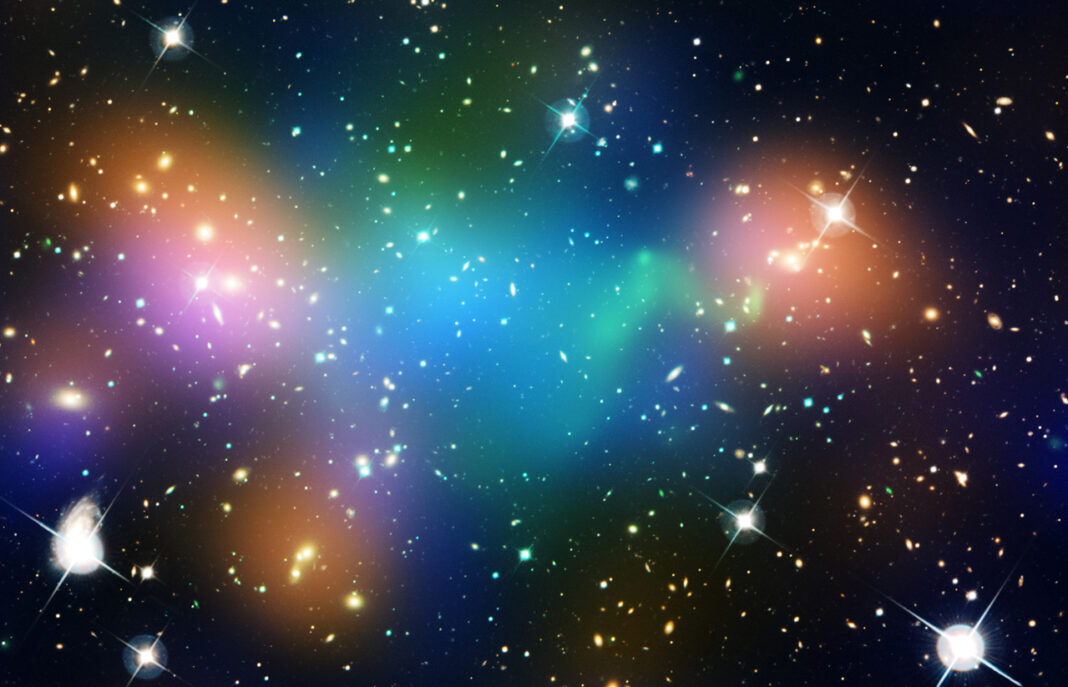Scientists are still puzzled about the nature of dark matter. Different models are being studied, especially from a particle physics approach. However, other theoretical frameworks not derived from particle physics are gaining attention, possibly opening up alternative answers to the same problem. In this article, I discuss the dark matter problem and three different perspectives of solution.
The dark matter problem arises from a survey of astronomical observations indicating that most structures in the universe have a “missed mass.” In other words, the observed mass is different from that predicted by the theory.
The dark matter problem resembles climate change research: several disconnected tested confirmations that acquire a deep meaning when we consider them as a whole. Climate change is not just a thermometer in a mountain as the dark matter was not only proposed after a discrepancy in a single observed galaxy.
This puzzle has become one of the most exciting topics in modern physics from a theoretical point of view and experimental efforts worldwide.
Two remarkable examples of dark matter evidence
The most popular and the first evidence in history was the “flat rotation curve” in galaxies that shows, in contrast to what gravitational theory anticipates, similar velocities of the stars in the middle of the galaxy as well as in the periphery. This fact indicates that an extra amount of mass, different from “normal matter,” must be included to increase the gravitational pull. Otherwise, the peripheral stars would fly away like projectiles.
High precision measurements of the Cosmic Microwave Background (CMB), an ancient light emitted when the universe was very young (around 300,000 years old), have shown that additional “exotic matter” is necessary to describe what we observe in its structure.
The early universe was dense and hot: a soup of individual particles moving very fast. In this regime, the light could not move freely and was absorbed, emitted, and constantly reabsorbed by electrons. When the universe cooled down, the charged particles lost their high energies forming atoms—allowing the photons to escape from the soup. This light, which comes directly from the young universe, fills the space and scientists can measure its temperature and determine its space distribution. This information is crucial to understanding the physics of this epoch of the universe.
Astronomers have found that the physical process described in the Standard Model of subatomic particles does not fully explain the current map of the cosmic microwave background: if we consider only the Standard Model of subatomic particles, our young universe would look extremely uniform. In contrast, what we really observe is an inhomogeneous pattern of radiation and to explain these anisotropies a kind of matter different from that included in the Standard Model must be added. The key point is that photons and matter remained coupled for too long in the cosmic history. Still, unlike what happens with ordinary matter, dark matter decouples early from the particles described by the standard model, allowing primordial inhomogeneities to grow. Consequently, without dark matter, the structures of the universe (galaxies, clusters, etc.) could never have been formed.
As we see, the dark matter hypothesis deals with multiple facets of nature as well as several specific problems.
Solving the dark matter problem: a review of some proposals
Dark Particles
The remarkable achievements of the Standard Model of subatomic particles in the last decades suggest that particle physics is the preferred framework to guide the discussión. The scientific literature is plagued with models that introduce new particle candidates with different masses and ways of interaction with regular matter, among other properties.
The most attractive proposal is the Weakly Interacting Slim Particle (WIMP) model, in which a complete history of the universe, including dark matter, can be accomplished by the inclusion of a massive particle (heavier than an electron) that interacts extremely weakly with the other standard model particles. These properties are necessary to produce a “dark particle” that does not generate light meanwhile producing an extra amount of gravity.
The searches for some of these new particle candidates are intense, a lot of experiments are being conducted worldwide using widely differing techniques from laser crossing walls, and particle colliders to paleo-detectors along with astrophysical and cosmological tests. However, despite these efforts, no evidence has been found. But “the absence of evidence is not the evidence of absence,” and the dark matter community awaits new experimental results. This is an important current area of research, and we may have exciting news in the future.
Alternative models
Since the particle physics framework has been unable to produce empirical evidence, why not explore another approximation to the problem? Indeed, alternative proposals exist, such as the Primordial Black Holes model and Modified Gravity theory. However, they are not the most regarded solutions within the dark matter community.
Primordial Black Holes
In recent years, the Primordial Black Holes model has gained attention as an interesting possibility. The standard black hole formation is rooted in astrophysical mechanisms such as gas clouds crashing or as a final stage of the star collapse process. In contrast, primordial black holes would have originated shortly after the big bang, when it was very dense and hot. In this extreme environment, seeds of energy inhomogeneities would have allowed the formation of these objects. Interestingly, these seeds would have evolved with the universe until today and could be the current dark matter. Consequently, the primordial black holes have specific features compared with astrophysical black holes; this allows us to test this hypothesis.
One of the main requirements of an astrophysical black hole is that its primordial star must have more than three solar masses. Under this condition, gravitational pressure is stronger than the nuclear reactions in the core, leading the star to a final black hole state. Only primordial black holes could have masses below three times the sun. A detection below this threshold can be considered direct evidence of these objects. Another possibility lies in the Cosmic Microwave Background. Primordial black holes could have emitted radiation during early times producing a small deviation of the radiation patterns and temperature fluctuations. As the cosmic measurement becomes more precise, we could learn more about possible deviations from standard cosmological models and primordial black holes formation possibility.
Modification of the Gravity Theory
A more controversial dark matter hypothesis is the modification of the gravitational theory. This paradigm does not introduce any additional matter, unlike the dark matter particles or Primordial Black Hole models. Instead, it considers a different mathematical structure from the current gravitation theory. In other words, the problem is not our knowledge about the matter in the universe but our (incomplete) knowledge of gravity.
Criticisms come from different flanks. One of them comes from a healthy scientific conservatism: why should the theory of General Relativity, one of the cornerstones of modern physics, be altered? After all, it is true that no evidence has been found against Einstein’s relativity principles (foundations) and no one could say that permanent efforts are not being carried out. Indeed, great experimental confirmations have been announced during the last century, such as gravitational waves or black holes images. Nonetheless, each of this evidence has a limited range of validity, leaving space for possible modifications where experimental confirmation still does not reach. For example, we do not know what happens at very high energy scales or microscopic lengths where quantum effects take place.
Modified Newtonian Gravity (MOND) is one of the most successful versions of this approach; this framework suggests a “minimum acceleration” for bodies moving in the galaxies.
Within this proposal, the acceleration of a body moving in a galaxy can never be zero and can only reach this “minimum value”. In this sense, a new scale (this minimum acceleration) of nature is introduced, altering the classical Newtonian theory. Interestingly, this minimum acceleration parameter is that it is possible to fit a “flat rotation curve” for some galaxies, thus avoiding the necessity for dark matter.
In a recent article, the relativistic variant of Modified Newtonian Gravity has successfully reproduced the cosmic microwave background structure. Before this finding, this theoretical approach encountered harsh criticisms. Although this is a great achievement, the idea is still in an early stage: it is a toy model that does not completely describe the physical reality. However, it has quickly received attention and has opened a window for future work on this topic, many physicists are trying to transform this academic model into a more realistic idea. Perhaps the controversial Modified Newtonian Gravity hypothesis will gain new supporters and become an expanded framework. Evidence and theoretical coherence will have the last words.
Scientists are still figuring out the road to solving the dark matter problem. The particle paradigm probably will keep its reliability for a while. On the other hand, it is also exciting to see the rise of alternative explanations, such as the Primordial Black Hole model and the Modify Gravity theory. Whether dark matter exists or not, the current discussion on the subject shows one of the most extraordinary characteristics of science: its capacity to embrace internal controversy without losing its certainty and trustworthiness.
References
Skordis, C., & Złośnik, T. (2021). New Relativistic Theory for Modified Newtonian Dynamics. Physical Review Letters, 127(16). https://doi.org/10.1103/physrevlett.127.161302
Schumann, M. (2019). Direct detection of WIMP dark matter: concepts and status. Journal of Physics G: Nuclear and Particle Physics, 46(10), 103003. https://doi.org/10.1088/1361-6471/ab2ea5
Villanueva-Domingo, P., Mena, O., & Palomares-Ruiz, S. (2021). A Brief Review on Primordial Black Holes as Dark Matter. Frontiers in Astronomy and Space Sciences, 8. https://doi.org/10.3389/fspas.2021.681084
To read more
Edwards, T. (2021, June 8). Digging for Dark Matter. United Academics Magazine › Connect Science and Society. https://www.ua-magazine.com/2019/02/15/digging-dark-matter/
(2020, August 3). An Alternative to Dark Matter Passes Critical Test. Quanta Magazine. https://www.quantamagazine.org/modified-gravity-theory-passes-a-critical-test-20200728/
Siegel, E. (2020, December 22). The One Big Problem With All Alternatives To Dark Matter And Dark Energy. Forbes. https://www.forbes.com/sites/startswithabang/2020/12/22/the-one-big-problem-with-all-alternatives-to-dark-matter-and-dark-energy/?sh=602d69a47f55
Featured illustration: NASA, ESA, CFHT, CXO, M.J. Jee (University of California, Davis), and A. Mahdavi (San Francisco State University)





